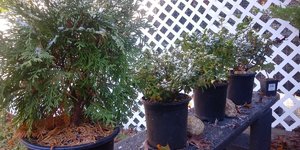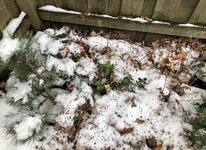Colorado
Masterpiece
Or could the cause be extreme hot or cold temperature fluctuations?
Uhhhh, yeah. Extreme temperature fluctuations brought by winter....
Or could the cause be extreme hot or cold temperature fluctuations?
Completely agree. Some people dont feed their trees in autumn and wonder why they dont bud the next spring. Or they repot at the wrong time and so forth. With that said, never had a properly managed tree die over winter. Not overwintering at low enough temps WILL kill some species once they are used to the cold. Red pine from Jeju go to Gangwon and dont freeze to death but Gangwon red pine that get taken to Jeju die because the winter is too warm. Takes them about 3 years to die but they pine away. (No pun intended)Trees need to build winter hardiness through successive exposures to sub freezing weather. I'd suspect that degree of severe cold exposure without previous lighter freezes would/could damage all but the most cold hardy species. With that being said, I DO believe that most trees that don't wake up from dormancy in the spring were likely not all that healthy entering dormancy the previous winter, or were mismanaged during the dormant period.
I am pretty sure he meant in the place where the trees are kept...for example a green house that gets too warm midwinter and then refreezes. That will definitely kill a tree half out of dormancy.Uhhhh, yeah. Extreme temperature fluctuations brought by winter....
Cold hardy trees need exposure to cold temps during dormancy, and they can withstand months of frozen soil during the winter months if they are kept out of the sun and wind, and temps in the root ball doesn't fall below a species specific level. Currently, my trees sit on my bench unless temps are going to fall into the lower 20s F. Colder then that and many go on the ground... the Rocky Mountain Junipers don't get any protection, though, even if it falls into the single digits- they are hardy to USDA zone 3 and laugh at what we call winter cold here in the South.I have often seen in photos where the trees are out in the open on display benches in winter with snow on top of them and it looks like they are not protected. How does that work?
Sorry! Been so busy with online lectures and making the new Korea Bonsai Association website. And dealing with corona issues. Glad to be back@BunjaeKorea where have you been hiding?
We live in similar zones! Zone 7 is the best ZoneCold hardy trees need exposure to cold temps during dormancy, and they can withstand months of frozen soil during the winter months if they are kept out of the sun and wind, and temps in the root ball doesn't fall below a species specific level. Currently, my trees sit on my bench unless temps are going to fall into the lower 20s F. Colder then that and many go on the ground... the Rocky Mountain Junipers don't get any protection, though, even if it falls into the single digits- they are hardy to USDA zone 3 and laugh at what we call winter cold here in the South.
Makes sense, but don't the evergreens still need sunlight in the winter? Also, if it's ok to let roots freeze is the killer when it temporarily warms back up above freezing and it's not watered?Cold hardy trees need exposure to cold temps during dormancy, and they can withstand months of frozen soil during the winter months if they are kept out of the sun and wind, and temps in the root ball doesn't fall below a species specific level. Currently, my trees sit on my bench unless temps are going to fall into the lower 20s F. Colder then that and many go on the ground... the Rocky Mountain Junipers don't get any protection, though, even if it falls into the single digits- they are hardy to USDA zone 3 and laugh at what we call winter cold here in the South.
Depends on the species and temp. The killer is usually freeze drying of roots...or windburn. Thats why snow is awesome stuff.Makes sense, but don't the evergreens still need sunlight in the winter? Also, if it's ok to let roots freeze is the killer when it temporarily warms back up above freezing and it's not watered?
Your example was a drastic 24 hour drop in temperatures. Many trees would go into shock over that. I have ficus you move to the other side of the bench and they drop leaves. We have pretty extreme heat here...it has been my experience that trees allowed to gradually acclimate to the climate change of a summer or winter seem to be healthier on the other side. On the other hand...trees that go from 92 degrees to below zero, or 90 degrees to 115 in a day do not stand a chance. That has more to do with how rapid the change was.Uhhhh, yeah. Extreme temperature fluctuations brought by winter....
Ah ok...well, it used to snow here every year but last several years have noticed a snow drought so maybe it would be best if I just heel them in a mulch bed away from wind and limited sun. Thanks all for starting this thread!Depends on the species and temp. The killer is usually freeze drying of roots...or windburn. Thats why snow is awesome stuff.
Dormant evergreens- those typically below 40 F- actually don't need sunlight as their metabolism has slowed way down. Think of alpine pines, junipers, spruce and fir that are covered by many feet of snow for 6 months or longer every winter and grow just fine when the snow melts. I kept evergreens in an unattached garage every winter from late November until late March/early April for a decade in MA, frozen solid on the concrete floor- never lost a tree (except for the ones girdled by mice) and they all grew well each spring.Makes sense, but don't the evergreens still need sunlight in the winter? Also, if it's ok to let roots freeze is the killer when it temporarily warms back up above freezing and it's not watered?
Sometimes when we are getting snow the temp is above freezing, maybe 34f. The snow accumulates on colder surfaces such as trees. Makes for nice pictures.I have often seen in photos where the trees are out in the open on display benches in winter with snow on top of them and it looks like they are not protected. How does that work?
That makes sense too. Sounds like I can really choose between either option. Right now thinking on heeling in the Junipers and Spruce but will cold garage the elm and maples.Dormant evergreens- those typically below 40 F- actually don't need sunlight as their metabolism has slowed way down. Think of alpine pines, junipers, spruce and fir that are covered by many feet of snow for 6 months or longer every winter and grow just fine when the snow melts. I kept evergreens in an unattached garage every winter from late November until late March/early April for a decade in MA, frozen solid on the concrete floor- never lost a tree (except for the ones girdled by mice) and they all grew well each spring.
This cracks me up, as I've been debating over the same issue. I have 2 egress window wells intended for some fall-collected larch - we were down to 30F this morning, but it was 47 down there! Had a piece of plywood over top so no light - monitoring the temps, I think once we are consistently under 40, it should be a nice even spot.I put mine in a window well with some clear plastic laid over the top. Its been in the low 20s nightly but not below like 48 in there so I’m a little concerned with it being too warm surprisingly. No heater or anything either! I am thinking I will just open the top slightly to cool it downin there. I have satsuki azaleas and jbps in there.
This is what I do. Only when frost is permanent I move them to the ground, out of wind and sun. I normally do not get snow, so my trees get tossed in whatever passed by.I have often seen in photos where the trees are out in the open on display benches in winter with snow on top of them and it looks like they are not protected. How does that work?







